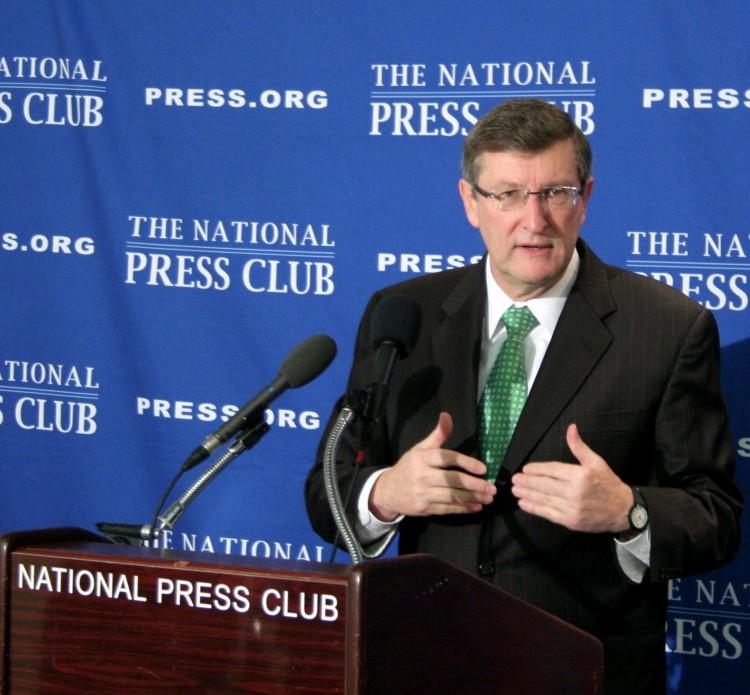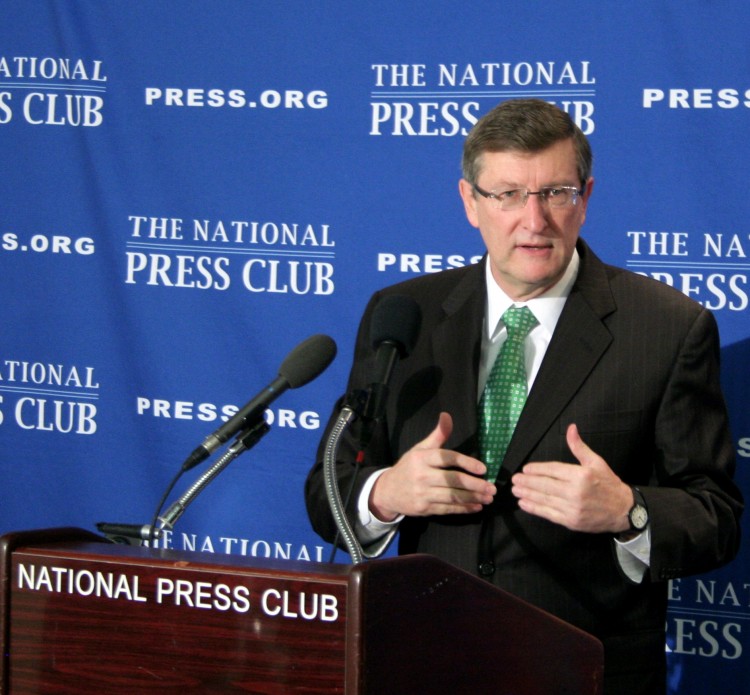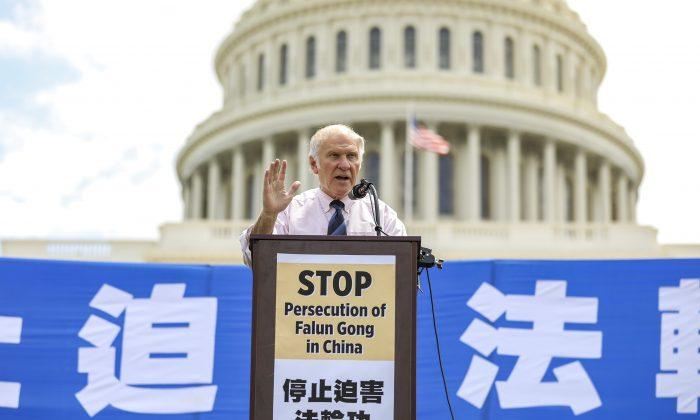WASHINGTON—During Sen. Kent Conrad’s (D-N.D.) Dec. 12 farewell speech on the Senate floor, he told a story about an event in 1964, when he was just 16 years old.
Conrad went to Washington, D.C., sat in the Senate gallery, and watched a debate on civil rights, led by Hubert Humphrey. Young Conrad was inspired by what he heard and saw that day. He knew that he would one day like to debate the great issues of the day. He returned home and wrote a note to himself to run for the Senate in about 20 years, in either 1986 or 1988. Indeed, he ran in 1986 and scored what Conrad said was the “biggest political upset in the history of our State.”
Conrad, a fifth-generation North Dakotan, is retiring this session after serving 26 years in the U.S. Senate.
One week after his farewell speech, Conrad, 64 and chair of the Senate Budget Committee, spoke at the National Press Club Newsmaker on his perspective of the so-called “fiscal cliff.”
Known as a “fiscal hawk,” Conrad brought with him several graphs and charts, making a compelling case for why we need higher tax rates for the wealthy along with substantial spending cuts. The latter is out of step with some of his Democratic Senate colleagues, but Conrad believes that we need these cuts to get the country back on solid fiscal footing.
Conrad was one of six senators appointed to the 2010 National Commission on Fiscal Responsibility and Reform, commonly referred to as the Simpson-Bowles commission. The bipartisan commission has often been cited as an example wherein Democrats and Republicans can compromise on the fiscal cliff talks and achieve a balance between revenue and spending.
Conrad voted with the majority for the Simpson-Bowles plan that proposed $4 trillion in deficit reduction. Other bipartisan commissions have come up with approximately the same number, according to Conrad.
“What we need to stabilize the debt and begin to work it down is a package of about $4 trillion in the next 10 years,” Conrad said.
He would have liked to seen a bigger package arise from the ongoing discussions between President Obama and Speaker John Boehner, but if there is any meaningful deficit reduction, an agreement would be “an important step forward,” according to Conrad.
Government Rescue
As a leader in the Senate, Conrad was invited to a meeting in the fall of 2008—the day before the Bush administration announced a takeover of the private insurance company AIG.
Widely criticized by Republicans, the rescue of AIG would ultimately cost $180 billion—“a staggering sum,” Conrad said at his farewell speech. However, Conrad observed that earlier in the week, it was announced that taxpayers are going to reap $22 billion on the transaction.
“I believe that the actions taken by the federal government at the end of the Bush administration and the beginning of the Obama administration that involved taking over AIG, the TARP [Troubled Asset Relief Program], and the Recovery Act, that these acts prevented a second Great Depression,” said Conrad.
He noted that two American economists, former vice chairman of the Federal Reserve Alan Blinder and former economic adviser to Sen. John McCain (R-Ariz.) Mark Zandi, hold the same opinion. A second Great Depression could have meant massive job losses and 16 percent unemployment.
The recovery has been remarkably quick, however, according to Conrad. In the fourth quarter of 2008, the economy was contracting at nearly 9 percent. By the third quarter of 2009, the economy had returned to positive growth. In just nine months, the economy returned to a state of growth.
“We have now had 13 consecutive quarters of economic growth,” according to Conrad, but now we must live with the consequences.
We are borrowing 31 cents for every dollar spent, which he said is “unsustainable” and “requires action.”
Based on Rogoff and Reinhart’s historical comparison, Conrad said in his Senate farewell speech that when the gross debt exceeds 90 percent of Gross Domestic Product (GDP), future economic growth is reduced quite significantly—by 25 to 33 percent.
Currently, the gross debt is at 104 percent of GDP and on its way to 115 percent by 2022.
Making His Case
To argue for both marginal tax rate increases for the wealthy and reductions in expenditures, Conrad used a chart that plots total revenues and total outlays going back to 1950, based on data from the Office of Management and Budget and the Congressional Budget Office.
The total revenue and total outlay are measured as a percentage of GDP. The chart shows clearly that the revenue for 2012 is at a 60 year low, while the spending in 2012 is almost at its peak. The difference between the two is $1.1 trillion, which is equal to the size of the national deficit for 2012.
In the five instances the budget has been balanced—1969, 1998, 1999, 2000, and 2001—revenue hovered at 20 percent of GDP. According to Conrad, people often say that revenue should be raised to its historical average of 18 or 18.5 percent, but he said that the budget has never been balanced at a mere 18 percent. He contends that the nation will need revenues in the 20 percent range, and he recommended 21 percent to the Simpson-Bowles commission, which was adopted.
Conrad said that his colleagues lack proper perspective on revenue increases and spending cuts.
For example, the president is calling for a $1.2 trillion (initially $1.6 trillion) increase in revenue over the next 10 years, placing the total amount of revenue raised during this period at $37.4 trillion. Such an increase is only 3.4 (initially 4.3) percent of the total revenue, according to Conrad.
On health care, Conrad’s chart shows proposed savings of $400 billion. The proposed savings would be 3.6 percent of baseline spending, which is $11.1 trillion. “Certainly we can save 3.6 percent by doing a better job of coordinating [care],” said Conrad.
“Both sides talk about the headline number but don’t put it in perspective,” he said, adding that if people would view the amounts in relationship to the total, it would not be so difficult to accept.
“We now spend too much of our time seeking partisan advantage, and it happens on both sides, and it is all understandable … I am not being critical of individuals,” he said. “We spend too little time trying to solve problems.”
Conrad also said that the focus has been too much on the earned income tax rate as well as making the top rate of 35 percent return to the rate during the Clinton years of 39.5 percent, while very little attention has been paid to unearned income—capital gains and dividends—taxed at only 15 percent.
According to Conrad, the 20 percent differential in tax rates cannot be justified. When he came to the Senate in 1987, he said that unearned income was taxed at 28 percent.
He cited a study by Martin Sullivan, published in Tax Notes in 2011, in which a hypothetical janitor for a New York City Park Avenue building would be taxed at 24.9 percent on an income of $33,080, whereas the residents in the building were taxed at 14.7 percent on an average income of $1,167,708 million.
“I don’t know how anybody can justify that as a fair sharing of the burden in this country,” said Conrad.
The Epoch Times publishes in 35 countries and in 20 languages. Subscribe to our e-newsletter.






